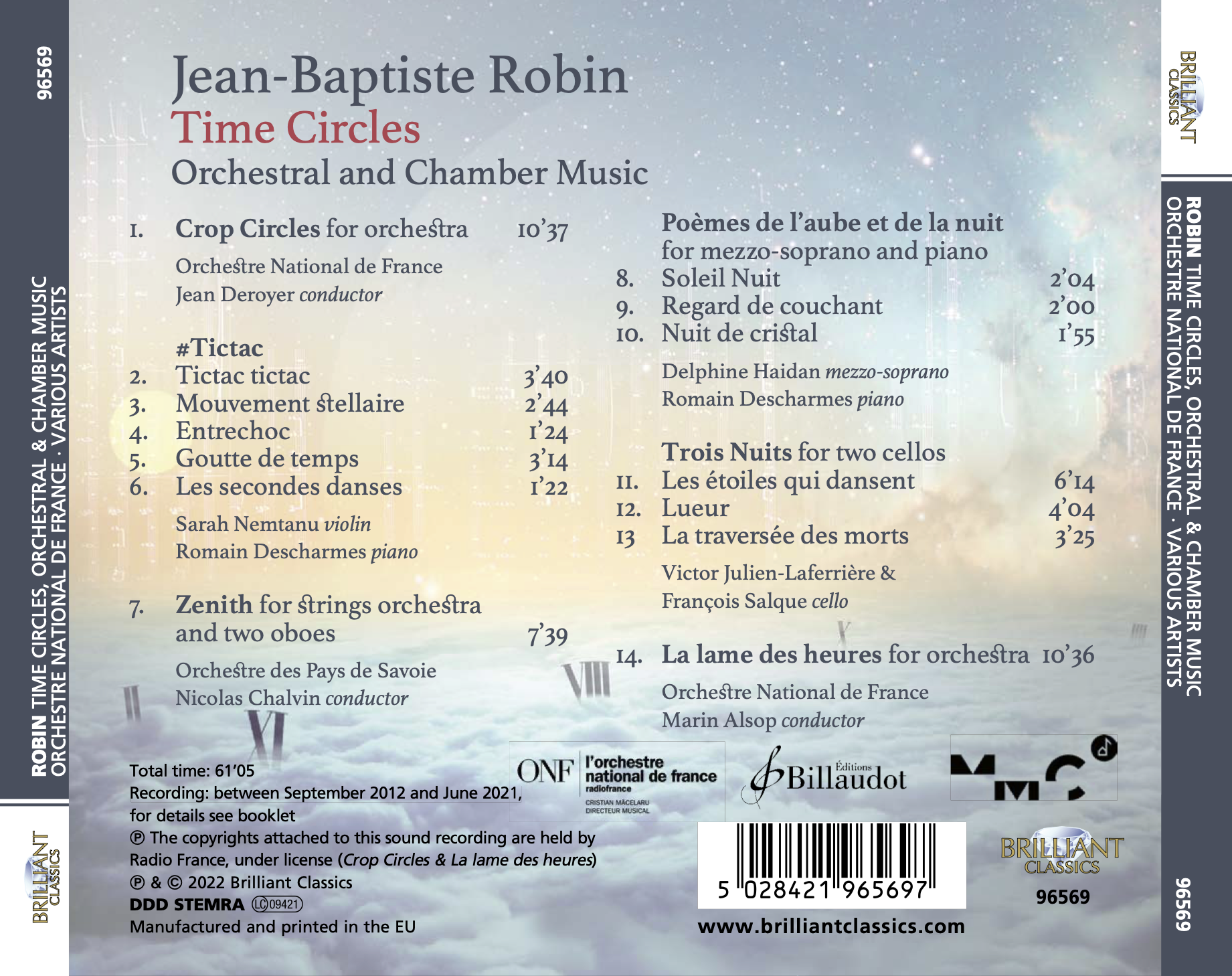J.B. Robin: Time Circles, Orchestral & Chamber Music
Orchestre National de France, Marin Alsop & Jean Deroyer conductors
Orchestre des Pays de Savoie, Nicolas Chalvin conductor
Sarah Nemtanu, violin
François Salque, Victor Julien-Laferrière, cellos
Delphine Haidan, mezzo-soprano
Romain Descharmes, piano
Cat. number : 96569
EAN code : 5028421965697
Release : December 2022
Click the link by listening :
![]() Free on YouTube
Free on YouTube
![]() on Spotify
on Spotify
![]() on Qobuz
on Qobuz
About this release
There is a prevailing theme at the heart of Jean-Baptiste Robin’s work, one from which this album draws its name (Time Circles) and can only be translated by the language of sounds: that of time moving inexorably forward, gradually altering beings and things in its path, on into death and oblivion. This recording focuses on Robin’s more recent output. (2012–2020).
The title of the first piece, Crop Circles (2012), refers to the man-made, symmetrical, geometric shapes found in crop fields. The slow introduction reveals two motifs: the first based on a symmetrical mode with a swirling melody, symbolising the geometrical designs of the Crop Circles in question; the second introduces the human element into this semi-natural, semi-artificial world. In the Allegro, ‘the initial swirling becomes a whirlwind’ (J.-B. Robin), then in the slow central section the second theme appears on the solo violin, evoking man at the centre of nature (the eye of the storm or the centre of the circle…). #Tictac (2019) was a commission from the Versailles Grand-Parc communauté de communes. This sonatina in five movements varies the tempi, rhythms and melodies, but is based throughout on the unrelenting movement of a pendulum. The opening tick-tock introduces the dominant motif, beginning the process of metamorphosis which develops throughout the movements.
Following the example of Crop Circles, Zénith (2020) brings together man and passing time through two juxtaposing or overlaying themes. A first section introduces the pizzicato tick-tock of time, then later the human theme appears alone and rises to an intense lyricism. A brief coda on the tick-tock: the struggle between man and time inevitably ends in the latter’s victory.
The theme of passing time is placed in a nocturnal setting in the three Poèmes de l'aube et de la nuit (Poems of the Dawn and the Night), wherein the unfolding of the night is ever perceived more slowly than the day. As such, there are no fast movements in these three poems, but instead alternating recitative sections and lyrical passages. The A-B-A' structure of the two first poems gives way to a through- composed structure in the third, which ends the piece with a piano postlude. Commissioned in 2014, Trois Nuits includes three movements and pays tribute to French composer Dutilleux. From the choreographic first movement to the recurring lament-like theme, the final increase of tempo leads the work to its infernal conclusion.
Much of La lame des heures (2019) is punctuated by the symbolic tick-tock: ‘Dark, mischievous, ill-tempered, heroic, the tick-tock takes on different characters and gradually appears as a blade that wounds, leaves scars, that never ceases.’ (J.-B. Robin). The near-constant dramatic tension of the piece is reminiscent of Crop Circles, and the final section culminates in the beating of twenty-four dissonant chords, symbolising the implacable cycle of the hours.
Gilles Thiéblot
Other information:
· Recorded between September 2012 and June 2021 in Paris and Chambéry
· Bilingual booklet in English and French contains liner notes by Giles Thielblot, along with biographies of the composer and artists
